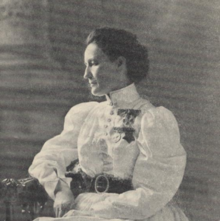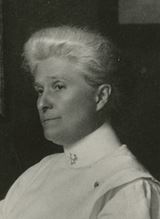
Anna Caroline Maxwell, was a nurse who came to be known as "the American Florence Nightingale". Her pioneering activities were crucial to the growth of professional nursing in the United States.
Nurse education consists of the theoretical and practical training provided to nurses with the purpose to prepare them for their duties as nursing care professionals. This education is provided to student nurses by experienced nurses and other medical professionals who have qualified or experienced for educational tasks, traditionally in a type of professional school known as a nursing school of college of nursing. Most countries offer nurse education courses that can be relevant to general nursing or to specialized areas including mental health nursing, pediatric nursing, and post-operative nursing. Nurse education also provides post-qualification courses in specialist subjects within nursing.
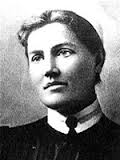
Isabel Adams Hampton Robb (1859–1910) was an American nurse theorist, author, nursing school administrator and early leader. Hampton was the first Superintendent of Nurses at the Johns Hopkins School of Nursing, wrote several influential textbooks, and helped to found the organizations that became known as the National League for Nursing, the International Council of Nurses, and the American Nurses Association. Hampton also played a large role in advancing the social status of nursing through her work in developing a curriculum of more advanced training during her time at the Johns Hopkins School of Nursing.
Myra Louise Taylor was nursing superintendent at St John's General Hospital in Newfoundland from 1916 for more than twenty years. She had been one of the first people to be educated at, and graduate from, the recently founded School of Nursing there. As superintendent she also had responsibility for the School. She had spent two years in London, England doing additional training and became a member of pioneering UK nursing organisations. During her time as superintendent at the St. John's hospital she was made a Fellow of the British College of Nurses.

Lystra Gretter was a Canadian-American nurse who devoted her career to improving the nursing field in Michigan, promoting nursing as a profession, and writing the Nightingale Pledge, a nurses' pledge.

Dame Emma Maud McCarthy, was a nursing sister and British Army matron-in-chief.

Dame Alicia Frances Jane Lloyd Still, was a British nurse, teacher, hospital matron and leader of her profession. She was one of the leaders in the campaign for state registration of nurses. Following the Nurses Registration Act 1919, she was a member of the General Nursing Council (1920-1937). As chairwoman of the General Nursing Council's first Education and Examinations Committee she helped establish the first national examination standards for the registration of nurses.

Louisa Elisabeth McLaughlin (1836–1921) was one of the first British women to serve as a nurse for the Red Cross. Louisa, who often spelled her name MacLaughlin and was familiarly called Louise, is pictured wearing medals awarded by both the French and Germans for running ambulances during the Franco-Prussian War of 1870. She also wears the Gold Cross of the Order of the Takova marking her work in the Serbo-Turkish war, the prelude to the Russo-Turkish War (1877–78). Her partner Emma Maria Pearson (1828–93) was awarded the same medals.

Mary Adelaide Nutting was a Canadian nurse, educator, and pioneer in the field of hospital care. After graduating from Johns Hopkins University's first nurse training program in 1891, Nutting helped to found a modern nursing program at the school. In 1907, she became involved in an experimental program at the new Teachers College at Columbia University. Ascending to the role of chair of the nursing and health department, Nutting authored a vanguard curriculum based on preparatory nursing education, public health studies, and social service emphasis. She served as president of a variety of councils and committees that served to standardize nursing education and ease the process of meshing nurse-profession interest with state legislation. Nutting was also the author of a multitude of scholarly works relating to the nursing field, and her work, A History of Nursing, remains an essential historic writing today. She is remembered for her legacy as a pioneer in the field of nursing, but also her activist role in a time where women still had limited rights.
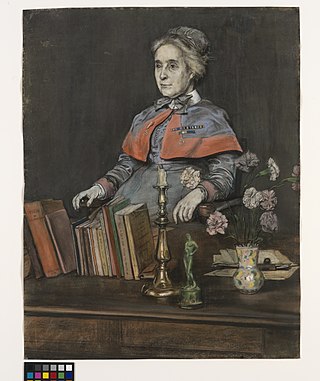
Dame Sidney Jane Browne, was the first appointed Matron-in-Chief of the newly formed Queen Alexandra's Imperial Military Nursing Service (QAIMNS). After she retired from the QAIMNS she was appointed as Matron-in-Chief of the Territorial Force Nursing Service. Browne was appointed a Dame Grand Cross of the Order of the British Empire in 1919 and, in 1922, she became the first President of the Royal College of Nursing, a post she held until 1925.

Jean Nellie Miles Walker RRC, was an Australian army nurse who served in Egypt during World War I. She was the only Tasmanian nurse to die on active service during World War I.

Mary Elizabeth Shellabarger was a Registered Nurse, army nurse overseas during World War I, and director of American Red Cross Nursing Service in Albania and Montenegro.

Major Margaret Clothilde MacDonald, was a Canadian military nurse. She is well known for being one of the first women to hold a position in the completely male-dominated military of her time. She is also known for her breakthrough role as a military nurse during the First World War. During this time, she was given the title of Matron-in-Chief of the Canadian Army Medical Corps Nursing Service. MacDonald was the first woman promoted to the rank of major in the British Empire and was awarded the Royal Red Cross (1916) and the Florence Nightingale Medal (1918).
Sara Iredell Fleetwood (1849–1908) was an American clubwoman and teacher. She was involved in the movement of black women into professional nursing, graduating as one of the first nurses from Howard University's Freedman's Hospital School of Nursing. She became the nursing superintendent at Freedman's, organized the Freedmen's Nursing Association and served as the first African American woman on the nurse's examining board of the District of Columbia.
Kate Evelyn Luard,, was a British nurse in the Second Boer War and First World War who was awarded the Royal Red Cross and Bar. She was the author of two books describing her experiences.
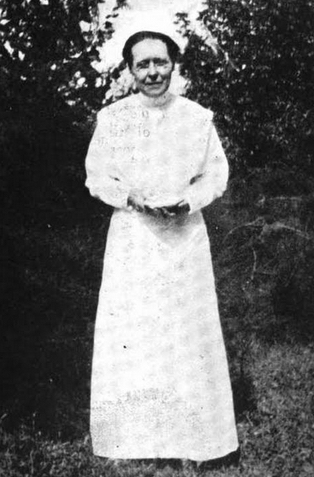
Mary Elizabeth Gladwin was an English-born American Red Cross nurse active in three wars. She was one of the first six American nurses to receive the Florence Nightingale Medal when it was awarded by the International Committee of the Red Cross in 1920.
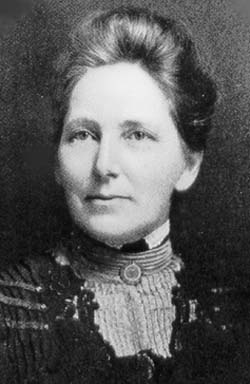
Sophia French Palmer was an American nurse, an editor and a health administrator. She was the first Editor-in-chief of the American Journal of Nursing. She was the President of the New York State Board of Nurse Examiners. She was also associated with the American Nurses Association, and various American Training Schools for Nurses including the Garfield Memorial Hospital. She made significant contributions in establishing a number of health institutions particularly in the field of nurse training.

Sara Elizabeth Parsons was an American nurse, writer and health administrator. She established nurse training schools in hospitals and asylums, and worked for the advancement of psychiatric nursing. She advocated the importance of giving autonomy for nurses, and sought public support for nursing education. She was the president of National League for Nursing Exam in 1916. In 1996, she was inducted into the American Nurses Association Hall of Fame.
